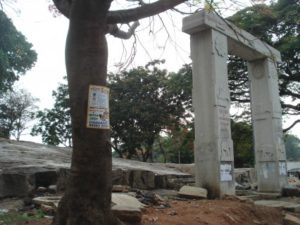Karnataka govt wants revenue-sharing deal for Bidadi township
January 21, 2019Swarathma: On the note of causes
January 23, 2019
This charming historical area takes you back in time today. But can it preserve itself for tomorrow? The Gavipuram Revival Project hopes to make a start.
Gavipuram almost reminds you of Hampi. There’s something romantic about the story of Kempegowda-I, founder-architect of Bangalore, choosing a hillock to build a cave-temple on top of it. The Kempambudhi lake, long winding slopes leading up to mantapas that used to serve as convention halls in the olden days, the watchtower built by Kempegowda II, the general air of old worldliness – in the characteristic hustle-bustle of Bangalore, the sedentary Gavipuram is charming.
From my first visit at the age of five, I remembered narrow lanes, walls lined with cow-dung cakes, hens and roosters running about, people huddled in small groups – and the composite smell of all of this in the air. Twenty years later, it is still the same. The locals have grown too comfortable recounting historic tales. Attempts to revive the place have not yielded much success. Tourists are few and outsiders don’t bother much. A local told us the story of a young girl who swam in the Kempambudhi lake for 48 hours and entering the Limca Book of Records. That was fifty years ago. After that, until a year ago, Kempambudhi lake was practically a swamp with sticky, five-inch thick algae covering the surface. New memories are few.
During a recent meeting organized by INTACH (Indian National Trust for Art and Cultural Heritage) to launch the ‘Gavipuram Project’ – aimed at reviving its cultural heritage, improving the infrastructure and making it tourist-friendly – this attachment to the past was palpable. Surprisingly, the only young people were a handful of journalists; and not-so-surprisingly, the old brigade spent much of the time reminiscing the past. So much so that the lure of nostalgia even managed to dodge the main question to a corner. “Will they ever discuss a plan to put this project in action?” murmured a girl seated next to me. We waited through the musings, coffee, and biscuits. Towards the end of the meeting, I had rich visual imagery of what Gavipuram used to be in the past but was clueless about its future. The intention was commendable but without a concrete plan.
There were some standalone do-able suggestions though, like putting up a guide-map at the entrance of Gavipuram, organizing tourist trips, documenting the history and culture of Gavipuram and organizing fairs to enhance participation from various classes and kinds of people in the area. This was interesting. But again, ideas become generally unreliable unless they are backed by timelines.
It’s not unexpected for such meetings to go without clear resolutions. As one of the attendees said, it’s because the questions themselves are not clear. Perhaps the best use of such meetings is to clarify the questions first. After all, a gathering of over 50 people may not be the best place to build action plans.

Here are the three things that I think the Gavipuram Project needs in order to be successful:
-
Firstly, a pointed agenda, backed by a dedicated team and local policymakers. The focus should be on execution.
-
Secondly, a feeling of ownership, either natural or inspired, must be developed among the various socio-economic groups living in the area. This could be done through talks and quiz competitions based on the theme of ‘Know-your-Gavipuram’. Locals who must be encouraged to lead these talks. They could share interesting anecdotes that they’ve picked up from their parents and grandparents.
-
Thirdly and very importantly, a business model must be built to sustain the project financially. For instance, picking one heritage spot a month and organizing painting and creative writing competitions there, based on the broad theme of that particular site. A nominal fee could be charged that could go into a ‘Gavipuram Revival Fund’ to track this. Also, one must leverage Basavanagudi’s legacy of being home to many literary figures including Masti Venkatesha Iyengar, DV Gundappa and YN Krishnamurthy. On special occasions like their birth anniversaries, ticketed events like poetry readings of their work talks by literary figures who knew them personally etc could be organized here. The point is to find avenues to generate funds and give participants a value for their buck.
Overall, I feel positive about the Gavipuram Project, despite its current lack of clarity, for two reasons. Firstly, so far only isolated groups have tried to revive Gavipuram but this time a reputed conservation organization, INTACH, has stepped in. It has started the Parichay walks here and says that the participation has been encouraging. Its members are open to ideas. For instance, my own suggestion that the project must have a sound business model and be self-sustaining in the long run was contemplated seriously.
Secondly, Gavipuram has an enthusiastic MLA, Ravi Subramanya, who seems committed to the project. He has cleaned up the stinking swamp that Kempambudhi lake was, and it is ready to store rainwater from this year. He also talked about the allocation of Rs 5 cr for developing the areas around the lake. In the next six months, he said that he plans to spend another Rs 6 cr to develop walking paths and bus routes to cover 12 heritage spots for tourists, recruit trained guides, set up route maps and tourist information centers.
All of this is still in the planning stage and might not seem enough to revive an isolated little townlet. But at least it promises to be the beginning of a foundation upon which the new identity of an old culture could thrive. And Kempegowda-I might just smile from the skies.
This story appeared in The Alternative. Read the original here.




